|
It's a strange enough scenery. Dilapidated beige brick walls rising and falling in semi-circles on a turn-set. They give off a hint of a Coliseum-like arena (bull fights!), of antique ruins (tragedy!), of crumbling romance ( love and death!), and when two of these walls turn around each other, there is even a shadow of Brünnhilde's Rock (magic spells!).
Forget color, folklore, sunny Spain of the original 1830 setting and get used to a drab and bitter 1930 update, a Carmen stripped of everything but obsession and deadly passion. If there was a political hind-thought of fascist Spain with these soldiers in brown and everyone onstage in oppressive beige-grey-brown uniformity, it's a lost cause. The conceptual construction of Bizet's opera by London theater director Richard Eyre overrides such attempted modernism with an archetypal fury — as if Carmen had to tighten her belt, cut the fat and reveal her naked, timeless essence.
A worthy symbol for this concept is the construction is Carmen's final dress — the one she goes down in at the end, when her lover knifes her to death. It's a one-shoulder-only black dress, very low-cut with a tight corseted bust and a skirt that trails two yards behind her in the dirt and sets scraps of paper flying like angry red moths when she whips it around. A slash of red fabric runs down across her heart like a long stream of blood. Apart from red detailing on the soldiers' uniforms. It's about the only bit of red onstage, although a similar red slash of blood marks the curtain during the ouverture. That this dress clings to Elina Garanca's body throughout the extended love-hate battle in the rubble behind the bull-fighting arena is something of a miracle. Roberto Alagno as Carmen's ill-fated Don José paws and claws and tears at her, goes after her in a full-body lunge to catch hold of her dress and keep her from leaving when she hears the applause for her latest lover, the Matador Escamillo, from the stadium. She falls, he assaults her in the dust, pins her down as she struggles to drag herself away from under him. He creeps along with her, smashes his knife into the ground right next to her face, and still, she provokes him further with her contempt, her refusal to bend to his passion. The elementary force of this fight to the death makes one breathless from the both the acting and the singing, and meanwhile, the dress stays on.
This powerfully controlled Carmen wouldn't have worked unless the director had a conductor who got every bit of fire and cursed magic out of Bizet's score – the young, energetic Canadian Yannick Nézet-Séguin in his Met debut – and two equally matched power-obsessives who were able to fill these bleary beige wall spaces to the brim. Lesser stars might easily have got squashed or lost in this setting. Don José has been Roberto Alagna's most successful role to date, partly because his gravelly, slightly nasal voice is so beautifully at home in his native French and in Bizet's wrenching music for Don José. But in Eyre's direction, the tenor was more intense and mesmerizing than I had ever seen him. When Don José corners Carmen at the end, the deserter and outlaw carries a cross around his neck and uses it to put a spell on her – a brilliant idea that makes sense of the bizarre proposition Don José brings to Carmen when he implores her to let him „save" her and himself. Alagno had consistently worked up the demented quality of a man who has „given up his honor, his very soul," as he cries out in his final struggle with Carmen.
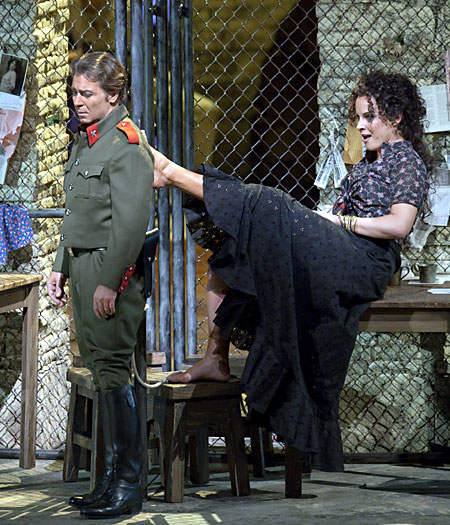 |
Latvian mezzo Elina Garanca proved herself his equal, a strange and mesmerizing Carmen, all fire under ice. She has the slender beauty and the seemingly effortless way of singing that are ideal for the camera. With her intensely ice-blue eyes and energetic chin, her face framed by an odd, curly wig, she looked like a double of the late German actress Romy Schneider (Empress „Sissi" in Visconti's film Ludwig). Garanca has shown before how easily she moves (in the Met Cinderella, in 2008?), but here she reveals herself as just enough of a natural dancer not to have to sweat and overdo or pretend. She does little – stomp, provocatively whisk her skirts and raise an arm with Flamenco panache — but she does it highly effectively (with the help of choreographer Christopher Wheeldon), while other Spanish-trained dancers capture part of the attention around her. (Among them Elisabeth Caballero and Sandra Piques Eddy as Carmen's highly attractive companions.)All along and especially in the seduction scenes Garanca appears astonishingly comfortable in her body, with a controlled relaxedness that is outright sexy. No mincing and no feminine wiles, thank God. Garanca is a class above bad acting. That said, she never fits the bill of a genuine Gypsy. Rather, she is the girl stolen from the castle and raised in a Gypsy camp. Well-raised, though, in the arts of thieving, fighting, cunning, spitting, saucy seduction of men, and other sadistic tricks of charm. Garanca has enough temperament and aggressiveness to be convincing as a free spirit whose power is bewitching because it withholds what it promises and scorns and ridicules mercilessly, as if with stabs of a knife.
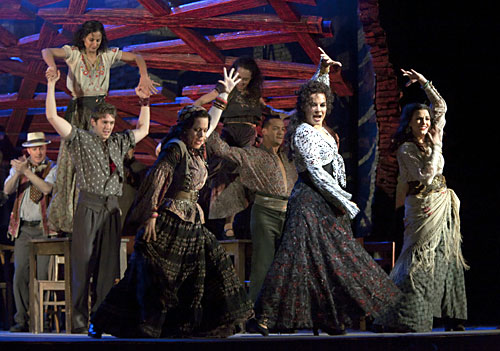 |
Garanca's admired role model for Carmen, Julia Migenes-Johnson in Carlo Rosi's beautiful filmed version from 1984, is simply in a class of her own (and here, all the Spanish folklore is put to optimal dramatic and sensuous use.) The comparison with Migenes-johnson brings home the natural limitation of any Caucasian singer in this Gypsy role. The sexual freedom Migenes-Johnson conveys with her small, earth-bound body, unshaved armpits, exotic face without make-up, and in her smoky, breathy voice, lies truly outside „the law", whereas the more recent interpretations all tend toward bosom-shaking, skirt-lifting, dry-humping, and thus remain safely within the male-imagined limits of stereotypical sex. There is a difference between the Gypsy Carmen and a slut or prostitute. But in our "raunch culture" this distinction seems to have got lost. Even at the end, when Carmen appears dolled up for her Escamillo and the fiesta, Migenes-Johnson remains a gypsy in her movements and gestures. But Garanca and her director can't resist the temptation of finally giving Carmen a star turn as a "lady." The love this Carmen then professes for her Matador is like a seriously bourgeois feeling. The castle has the last word.
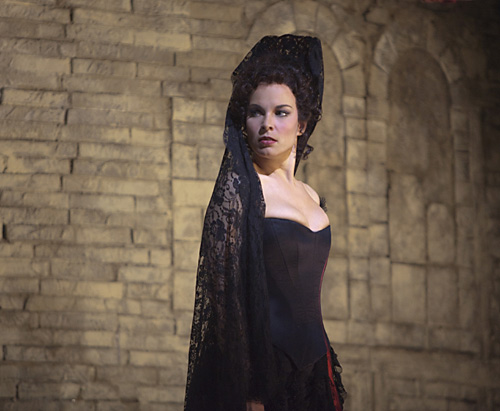
What is interesting in Garanca's portrayal is that her almost „masculine" power, her conniving, cold resolve and spitting pride pair perfectly with the „feminine" qualities Alagna brings out in Don José: his easily flattered, passive softness, pudgy weakness and emotional intensity. Alagna makes it believable that Carmen would be caught by this first truly passionate lover among her many men — the lover insane enough to sacrifice himself to the demon of his obsession.
In the intermission interviews, the conductor and everybody else agreed that Alagna and Garanca are the most perfectly matched Carmen and Don José of today (some opera lovers might count in Jonas Kaufmann and Anna Caterina Antonacci in Francesca Zambello's London Carmen of 2007, out on DVD). This perfect match is the ironic outcome of the rocky real-life relationship of the tenor with his wife, diva Angela Gheorghiu. Last August, Gheorghiu withdrew from the first sixCarmens at the Met because she was unwilling, it turned out, to sing the role together with her husband.
Garanca's Carmen seemed to grow with the opera's dark spell; her best moments were the less smiling, flirtatious ones. Her voice was beautifully focused, pitch-perfect and – to my ear technically evolved. In the past, it could sound a bit muffled and flat, especially in combination with Anna Netrebko's much more soaring voice (the two new female stars are often paired in Europe and considered another one of opera's „dream couples"). But here, with no soprano rival, Garanca had a more obvious shine, with a notable outpouring sound. Her voice is hard to describe. Not exactly of touching emotional beauty, it is intriguing in its darkness and, at moments, stirring. It is not huge, but big enough to pair well with Alagno's strong tenor, and flexibly athletic enough to soar over the orchestra and through the dances, even when she is lifted in the air flat on her back in the tavern scene.
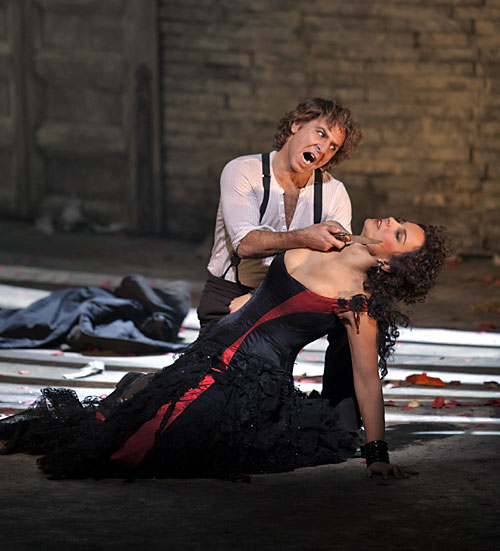
The Met's new Carmen replaces an old Zefirelli production – like the misbegotten Tosca that opened the season (see Scene 4, Nov. 2009), another modernisation with a lot of brick walls. Not everything was perfect here either.
An entirely missed opportunity was the appearance of the gypsy women from the tobacco factory. Instead of a gushing, mind-boggling amount of flesh and beauty rushing in on the spectator (as in Rosi's and Zambello's versions), Eyre makes them dribble, so to speak, by bringing them out one by one from a hole in the stage floor. Then he artificially and stiffly decorates the stage with them. Fortunately, when Carmen at last climbs out of the pit, she has a few ideas of what to do with herself. She washes her legs in a bucket, flirts around, provokes, hisses at a rival, and finally slaps her flower onto Don Jose's chest like a dagger.
A miscalculation is the village girl Michaela's visit with the soldiers when she comes to look for Don Jose. Eyre lets the soldiers grossly paw and harrass her as if a lamb had entered a lions' den for slaughter, but then he has the girl, who looks like a suburb shop-girl (Barbara Frittoli), respond to one of them as if she were touched and tempted. None of it makes sense.
The worst mistakes, as always in opera, are the ballet interludes. It's ironic that a director who bans all the folklore from Carmen, lets the Carmen-kitsch reenter through this back door. Christopher Wheeldon, one of America's famous young choreographers, tries to illustrate the relationship between Carmen and Don Jose during the ouverture and the prelude to Act III. The first one is supposed to show „their fate": a would-be Béjart act of sex-on-stage with the help of a woman wrapped around a male torso, splaying her legs — a banality if ever there was one. It doesn't get any better the next time, when Wheeldon fills in what the opera wisely leaves to the imagination: the missing sex scene between Carmen and Don José. We have to suffer through a sappy, vapid „Romeo and Juliet" pas de deux just when we are ready for the Gypsy and her lover to express a dangerous violence. That a modern choreographer would imagine this ferocity of passion as young, innocent wafting of arms and floating hair, could make one laugh if it weren't so irritating in its naiveté.
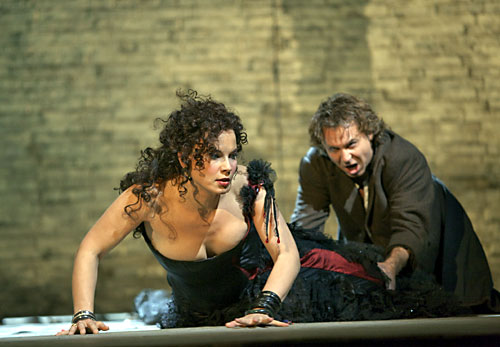
Eyre ends his Carmen with a surprising last image : in sync with the final shattering notes of the score, the set turns away from the dead woman and her murderer. Drenched in red light, the arena appears with the bloodied bull lying at the feet of the victorious Escamillo. Two sides of the same coin: the male heroes have each successfully killed off what they love.
Some statistics: The Live at the Met simulcast of Carmen sold an estimated 140,000 tickets for 700 screens in North America and a 100,000 more for 300 screens in 37 countries in Europe and Latin America. The total topped the Met's previous mark of 197,000 last March 7 for Puccini's Madama Butterfly.
The Met estimates that the total audience for Carmen including delayed showings (you may still be able to catch en encore performance at a movie theater near you) will be 320,000, bettering the 285,000 for Butterfly.
Photos by Ken Howard - Courtesy Metropolitan Opera
|

